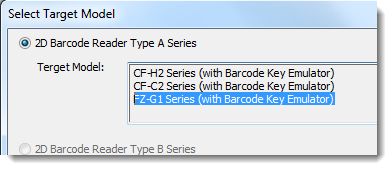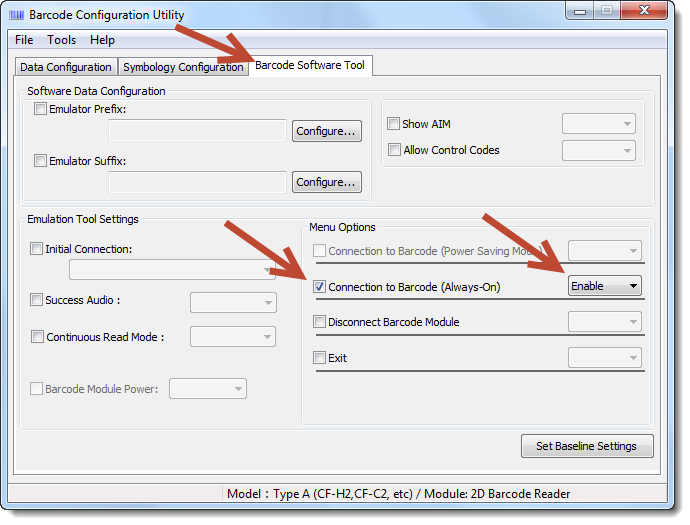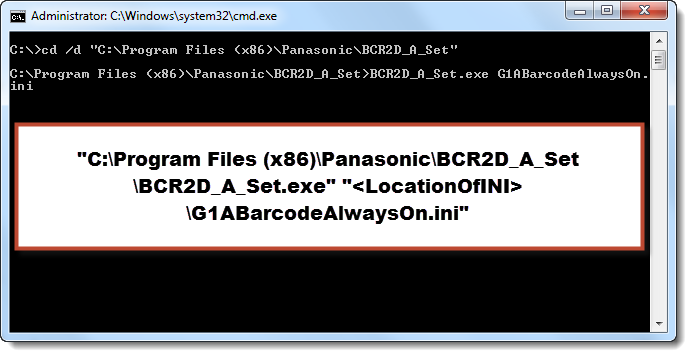The reason for a custom script, is that the customer wanted to see a prompt displaying how large the backup .MIG file would be before initiating the backup.
The script was used in an SCCM 2012/MDT 2012U1 UDI Task Sequence. I kicked off the script using a “Run a Command Line” step and used the “ServiceUI.exe” application, because the script displays a prompt that needs to be visible to the user. The prompt displays an estimate on how large the .MIG file will be, if the file is too large, the deployment technician can skip the User Capture.
The process is split in 2 scripts (CaptureUserState.vbs and RestoreUserState.vbs):
CaptureUserState.vbs:
'==========================================================================
' NAME: CaptureUserState.vbs
'
' AUTHOR: Brian Gonzalez
' DATE : 12.11.2013
'
' Changlog:
' 12.11.13 - First revision
'
' PURPOSE: User State Capture Script.
'==========================================================================
'On Error Resume Next
'Setup Objects, Constants and Variables.
Set oFSO = CreateObject("Scripting.FileSystemObject")
Set oShell = WScript.CreateObject("WScript.Shell")
Set oNetwork = WScript.CreateObject("WScript.Network")
Const ForReading = 1, ForWriting = 2, ForAppending = 8
sScriptFolder = oFSO.GetParentFolderName(Wscript.ScriptFullName) 'NoTrailingBS
sScriptVerNumber = "1.3"
'Network Share Variables
sDriveLetter = "U:"
sShare = "\\<ServerShare>\<ShareFolder>"
sUser = "<UserName>"
sPass = "<Password>"
'Close SCCM Progress UI
Set oTSProgressUI = CreateObject("Microsoft.SMS.TSProgressUI")
Set oEnvironment = CreateObject("Microsoft.SMS.TSEnvironment")
oTSProgressUI.CloseProgressDialog()
sCompName = oEnvironment("OSDComputerName")
Set oLogFile = oFSO.CreateTextFile("X:\Windows\Temp\SMSTSLog\CaptureUserState.log", ForWriting, True)
oLogFile.WriteLine Time & ": Kicked Off Script(CaptureUserState.vbs v" & sScriptVerNumber & ")"
If oFSO.FolderExists("C:\Program Files\Internet Explorer") Then
sOfflineWinDir = "C:\Windows"
ElseIf oFSO.FolderExists("D:\Program Files\Internet Explorer") Then
sOfflineWinDir = "D:\Windows"
ElseIf oFSO.FolderExists("E:\Program Files\Internet Explorer") Then
sOfflineWinDir = "E:\Windows"
ElseIf oFSO.FolderExists("F:\Program Files\Internet Explorer") Then
sOfflineWinDir = "F:\Windows"
Else
sOfflineWinDir = "Not Found"
oLogFile.WriteLine Time & ": No Windows Directory Found, exiting script(10)."
Wscript.Quit(10)
End If
oLogFile.WriteLine Time & ": Windows Directory Found:" & sOfflineWinDir
oLogFile.WriteLine Time & ": Attempt to map network drive."
sCmd = "CMD /C NET USE " & sDriveLetter & " /DELETE"
oLogFile.WriteLine Time & ": About to run(" & sCmd & ")."
sRet = oShell.Run(sCmd, 1, True)
sCmd = "CMD /C NET USE " & sDriveLetter & " """ & sShare & """ /USER:" & sUser & " " & sPass
'oLogFile.WriteLine Time & ": About to run(" & sCmd & ")."
sRet = oShell.Run(sCmd, 0, True)
If NOT oFSO.FolderExists("U:\") Then
oLogFile.WriteLine Time & ": Failed to map network drive(" & sShare & "). Exiting Script(1)."
Wscript.Quit(1)
End If
oLogFile.WriteLine Time & ": Mapped U: Successfully."
sStorePath = "U:\" & sCompName & "\StateStore"
oLogFile.WriteLine Time & ": Begin to pull estimate of USMT file size."
sCmd = """" & sScriptFolder & "\scanstate.exe"" """ & sStorePath & _
""" /c /i:""" & sScriptFolder & "\MigDocs.xml"" /i:""" & sScriptFolder & _
"\ManateeCaptureUSMT.XML"" /config:""" & sScriptFolder & _
"\config.xml"" /offline:""" & sScriptFolder & _
"\Offline.xml"" /l:""X:\Windows\Temp\SMSTSLog\USMTCapture.log"" /o /uel:30 /p:""X:\Windows\Temp\SMSTSLog\USMTEstimate.log"" /v:13"
oLogFile.WriteLine Time & ": About to run(" & sCmd & ")."
sRet = oShell.Run(sCmd, 1, True)
If sRet <> 0 Then
oLogFile.WriteLine Time & ": Failed to pull USMT Estimate(" & sShare & "). Exiting Script(1)."
Wscript.Quit(1)
End If
Set oEstimateFile = oFSO.OpenTextFile("X:\Windows\Temp\SMSTSLog\USMTEstimate.log")
sEstimateFileContents = oEstimateFile.ReadAll
sSizeEstimate = (Round((RegExpTest("[0-9]{1,}(?=</size)", sEstimateFileContents) / 1048000),1))
oLogFile.WriteLine Time & ": Successfully pulled USMT Estimate of: " & sSizeEstimate
sAnswer = oShell.Popup("Would you like to continue the user state capture routine? " & vbCrlf & _
"(Estimated .MIG Size: " & sSizeEstimate & " MB)",, "USMT Prompt", 4)
If sAnswer = "7" Then 'Answered NO
oLogFile.WriteLine Time & ": User specified to not copy data. Exiting Script(10)."
'CopyLogFile
Wscript.Quit(10)
End If
sCmd = """" & sScriptFolder & "\scanstate.exe"" """ & sStorePath & """" & _
" /c /i:""" & sScriptFolder & "\MigDocs.xml"" /i:""" & sScriptFolder & _
"\ManateeCaptureUSMT.XML"" /config:""" & sScriptFolder & _
"\config.xml"" /offline:""" & sScriptFolder & "\Offline.xml"" /l:""X:\Windows\Temp\SMSTSLog\USMTCapture.log"" /o /uel:30 /v:13"
oLogFile.WriteLine Time & ": About to run(" & sCmd & ")."
sRet = oShell.Run(sCmd, 1, True)
sMIGFilePath = sStorePath & "\USMT\USMT.mig"
If oFSO.FileExists(sMIGFilePath) Then
oLogFile.WriteLine Time & ": Successfully ran USMT Capture Routine to """ & sMIGFilePath & """"
sCmd = "CMD /C NET USE " & sDriveLetter & " /DELETE"
oLogFile.WriteLine Time & ": About to run(" & sCmd & ")."
Wscript.Quit(0)
Else
oLogFile.WriteLine Time & ": Failed to run USMT Capture Routine to """ & sMIGFilePath & """. Check the ""X:\Windows\Temp\SMSTSLog\USMTCapture.log""(1)."
sCmd = "CMD /C NET USE " & sDriveLetter & " /DELETE"
oLogFile.WriteLine Time & ": About to run(" & sCmd & ")."
Wscript.Quit(1)
End If
Function RegExpTest(strMatchPattern, strPhrase)
Set objRegEx = New RegExp
objRegEx.Global = True
objRegEx.IgnoreCase = True
objRegEx.Pattern = strMatchPattern
Set Matches = objRegEx.Execute(strPhrase)
RegExpTest = Matches(0).Value
End Function
RestoreUserState.vbs:
'==========================================================================
' NAME: RestoreUserState.vbs
'
' AUTHOR: Brian Gonzalez
' DATE : 12.11.2013
'
' Changlog:
' 12.11.13 - First revision
'
' PURPOSE: User State Capture Script.
'==========================================================================
On Error Resume Next
'Setup Objects, Constants and Variables.
Set oFSO = CreateObject("Scripting.FileSystemObject")
Set oShell = WScript.CreateObject("WScript.Shell")
Set oNetwork = WScript.CreateObject("WScript.Network")
sSystemDriveLetter = oShell.ExpandEnvironmentStrings("%SystemDrive%")
sCompName = oShell.ExpandEnvironmentStrings("%ComputerName%")
Const ForReading = 1, ForWriting = 2, ForAppending = 8
sScriptFolder = oFSO.GetParentFolderName(Wscript.ScriptFullName) 'NoTrailingBS
sScriptVerNumber = "1.0"
'Network Share Variables
sDriveLetter = "R:"
sShare = "\\<ServerShare>\<ShareFolder>"
sUser = "<UserName>"
sPass = "<Password>"
'Close SCCM Progress UI
Set oTSProgressUI = CreateObject("Microsoft.SMS.TSProgressUI")
Set oEnvironment = CreateObject("Microsoft.SMS.TSEnvironment")
oTSProgressUI.CloseProgressDialog()
If oFSO.FolderExists(sSystemDriveLetter & "\_SMSTaskSequence\Logs") Then
sLogFilePath = sSystemDriveLetter & "\_SMSTaskSequence\Logs\RestoreUserState.log"
sLogFolder = sSystemDriveLetter & "\_SMSTaskSequence\Logs"
ElseIf oFSO.FolderExists(sSystemDriveLetter & "\Windows\CCM\Logs\SMSTSLogs") Then
sLogFilePath = sSystemDriveLetter & "\Windows\CCM\Logs\SMSTSLogs\RestoreUserState.log"
sLogFolder = sSystemDriveLetter & "\Windows\CCM\Logs\SMSTSLogs"
ElseIf oFSO.FolderExists(sSystemDriveLetter & "\Windows\CCM\Logs") Then
sLogFilePath = sSystemDriveLetter & "\Windows\CCM\Logs\RestoreUserState.log"
sLogFolder = sSystemDriveLetter & "\Windows\CCM\Logs"
Else
sLogFilePath = sSystemDriveLetter & "\Windows\Temp\RestoreUserState.log"
sLogFolder = sSystemDriveLetter & "\Windows\Temp"
End If
Set oLogFile = oFSO.CreateTextFile(sLogFilePath, ForWriting, True)
oLogFile.WriteLine Time & ": Kicked Off Script(RestoreUserState.vbs v" & sScriptVerNumber & ")"
If oFSO.FolderExists("X:\Windows") Then
oLogFile.WriteLine Time & ": Running in WinPE OS, script must be run in Windows 7. Exiting Script(1)."
Wscript.Quit(1)
End If
If oFSO.FolderExists("C:\Program Files\Internet Explorer") Then
sWinDir = "C:\Windows"
ElseIf oFSO.FolderExists("D:\Program Files\Internet Explorer") Then
sWinDir = "D:\Windows"
ElseIf oFSO.FolderExists("E:\Program Files\Internet Explorer") Then
sWinDir = "E:\Windows"
ElseIf oFSO.FolderExists("F:\Program Files\Internet Explorer") Then
sWinDir = "F:\Windows"
Else
oLogFile.WriteLine Time & ": No Windows Directory Found, exiting script(10)."
Wscript.Quit(10)
End If
oLogFile.WriteLine Time & ": Windows Directory Found:" & sWinDir
oLogFile.WriteLine Time & ": Attempt to map network drive."
sCmd = "CMD /C NET USE """ & sDriveLetter & """ /DELETE"
oLogFile.WriteLine Time & ": About to run(" & sCmd & ")."
sRet = oShell.Run(sCmd, 1, True)
sCmd = "CMD /C NET USE " & sDriveLetter & " """ & sShare & """ /USER:" & sUser & _
" " & sPass
'oLogFile.WriteLine Time & ": About to run(" & sCmd & ")."
sRet = oShell.Run(sCmd, 1, True)
If NOT oFSO.FolderExists(sDriveLetter & "\") Then
oLogFile.WriteLine Time & ": Failed to map network drive(" & sShare & "). Exiting Script(1)."
Wscript.Quit(1)
End If
oLogFile.WriteLine Time & ": Mapped " & sDriveLetter & " Successfully."
sMIGFilePath = sDriveLetter & "\" & sCompName & "\StateStore\USMT\USMT.mig"
sStorePath = sDriveLetter & "\" & sCompName & "\StateStore"
If oFSO.FileExists(sMIGFilePath) Then
oLogFile.WriteLine Time & ": MIG file for Computer was located """ & sMIGFilePath & """."
Else
oLogFile.WriteLine Time & ": MIG file for Computer was not located """ & sMIGFilePath & """.(10)"
Wscript.Quit(10)
End If
oLogFile.WriteLine Time & ": Begin to run loadstate using USMT file size:" & sMIGFilePath
sCmd = """" & sScriptFolder & "\loadstate.exe"" """ & sStorePath & _
""" /i:""" & sScriptFolder & "\MigDocs.xml"" /i:""" & sScriptFolder & _
"\ManateeCaptureUSMT.XML"" /config:""" & sScriptFolder & _
"\config.xml"" /l:""" & sLogFolder & "\USMTRestore.log"" /v:13"
oLogFile.WriteLine Time & ": About to run(" & sCmd & ")."
sRet = oShell.Run(sCmd, 1, True)
If sRet <> 0 Then
oLogFile.WriteLine Time & ": Failed to restore User Data. Exiting Script(1). Review the: " & sLogFolder & "\USMTRestore.log"
sCmd = "CMD /C NET USE """ & sDriveLetter & """ /DELETE"
oLogFile.WriteLine Time & ": About to run(" & sCmd & ")."
sRet = oShell.Run(sCmd, 1, True)
Wscript.Quit(1)
Else
oLogFile.WriteLine Time & ": Restore of data was successful."
sCmd = "CMD /C NET USE """ & sDriveLetter & """ /DELETE"
oLogFile.WriteLine Time & ": About to run(" & sCmd & ")."
sRet = oShell.Run(sCmd, 1, True)
Wscript.Quit(0)
End If
/BG







